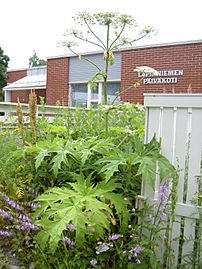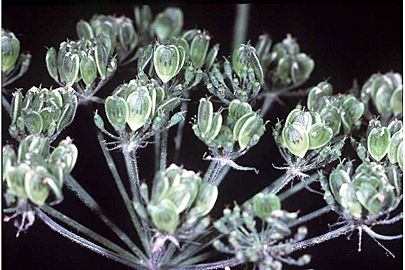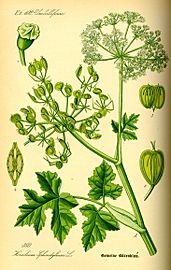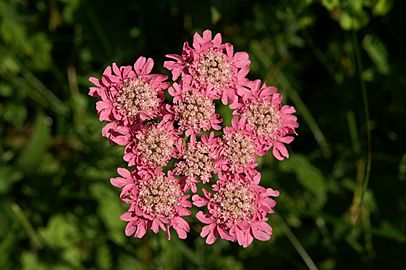Heracleum (plant) facts for kids
Quick facts for kids Heracleum (plant) |
|
|---|---|
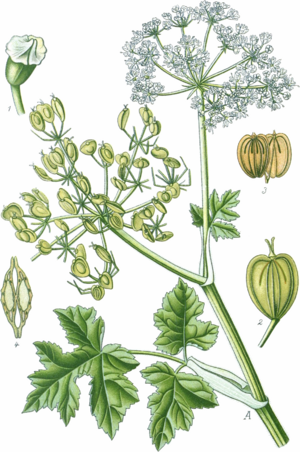 |
|
| Heracleum sphondylium | |
| Scientific classification |
|
| Kingdom: | Plantae |
| Clade: | Tracheophytes |
| Clade: | Angiosperms |
| Clade: | Eudicots |
| Clade: | Asterids |
| Order: | Apiales |
| Family: | Apiaceae |
| Subfamily: | Apioideae |
| Genus: | Heracleum L. |
| Synonyms | |
|
|
Heracleum is a group of plants often called hogweed or cow parsnip. These plants can live for two years (biennial) or many years (perennial). They belong to the carrot family, called Apiaceae. You can find them in cool areas across the northern part of the world and in tall mountains as far south as Ethiopia.
The name Heracleum was given by a famous scientist named Carl Linnaeus in 1753. It comes from an Ancient Greek word meaning "of Heracles", who was a strong hero in old myths.
Contents
Different Kinds of Hogweed
Many plants in the Heracleum family look quite similar. However, one type, H. mantegazzianum, stands out because it grows very large.
Here are some common types of hogweed:
- Heracleum mantegazzianum, known as giant hogweed. This plant comes from the Caucasus region in Eurasia. It is a serious invasive species in many parts of Europe and North America. This means it spreads easily and can harm local plants.
- Heracleum sosnowskyi, or Sosnowsky's hogweed. It is native to the eastern Caucasus. This plant is a common weed across Europe and Asia.
- Heracleum persicum, also called Persian hogweed. It grows naturally in Iran, Iraq, and Turkey.
- Heracleum sphondylium, or common hogweed. You can find this plant naturally in Europe and Asia.
- Heracleum maximum, known as cow parsnip. This type is common and native to North America.
-
Cow parsnip, Heracleum maximum
Plant Names and How They Are Classified
Some Heracleum species, like H. mantegazzianum, H. sosnowskyi, and H. persicum, look very much alike, except for their size. The name "giant hogweed" usually means H. mantegazzianum. But in some places, it can mean all three of these similar large plants.
Also, H. maximum and H. sphondylium are both often called cow parsnip. To avoid confusion, people sometimes call them American cow parsnip and European cow parsnip.
It can be hard to tell different Heracleum species apart because they look so similar. This has led to many different names for the same plant over time. For example, the plant now known as H. maximum used to be called H. lanatum. Before the year 2000, H. lanatum was more popular, but now H. maximum is the common scientific name.
Safety: Why Some Hogweeds Can Be Harmful
Most Heracleum plants can cause a skin reaction called phytophotodermatitis. This means your skin becomes very sensitive to sunlight after touching the plant. Giant hogweed (H. mantegazzianum) is especially known for causing these public health risks.
At least 36 types of Heracleum plants have chemicals called furanocoumarin. These chemicals make human skin sensitive to sunlight. Out of these, at least 25 types contain a chemical called psoralen (either bergapten or methoxsalen). Three specific types—H. mantegazzianum, H. sosnowskyi, and H. sphondylium—have both of these psoralen chemicals. If you get the sap on your skin and then go into the sun, it can cause painful blisters and burns.
See also
 In Spanish: Heracleum para niños
In Spanish: Heracleum para niños


